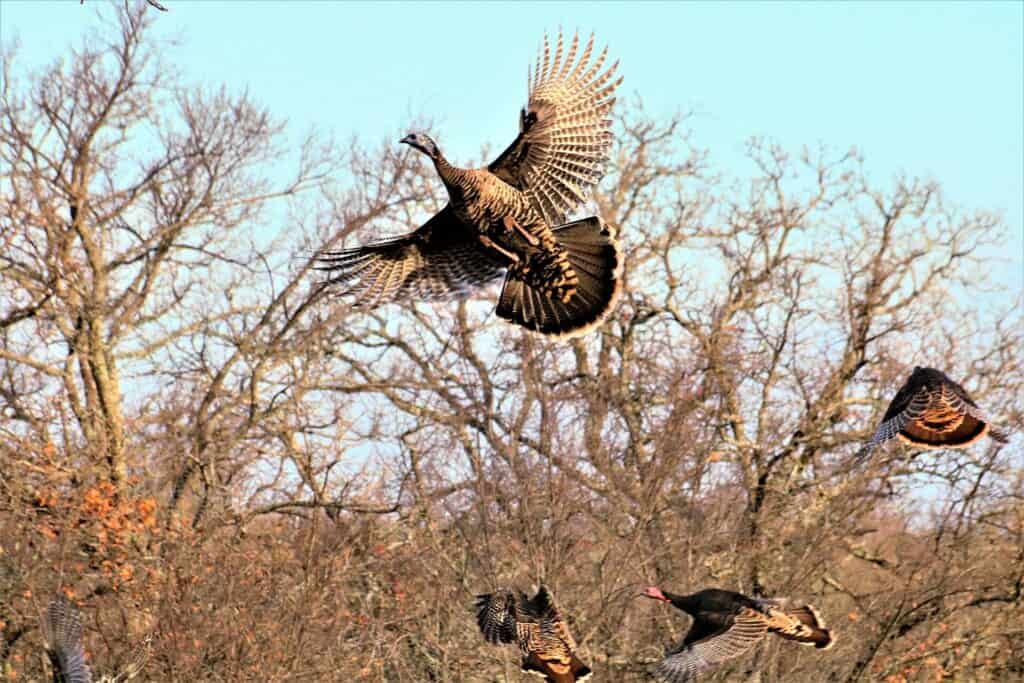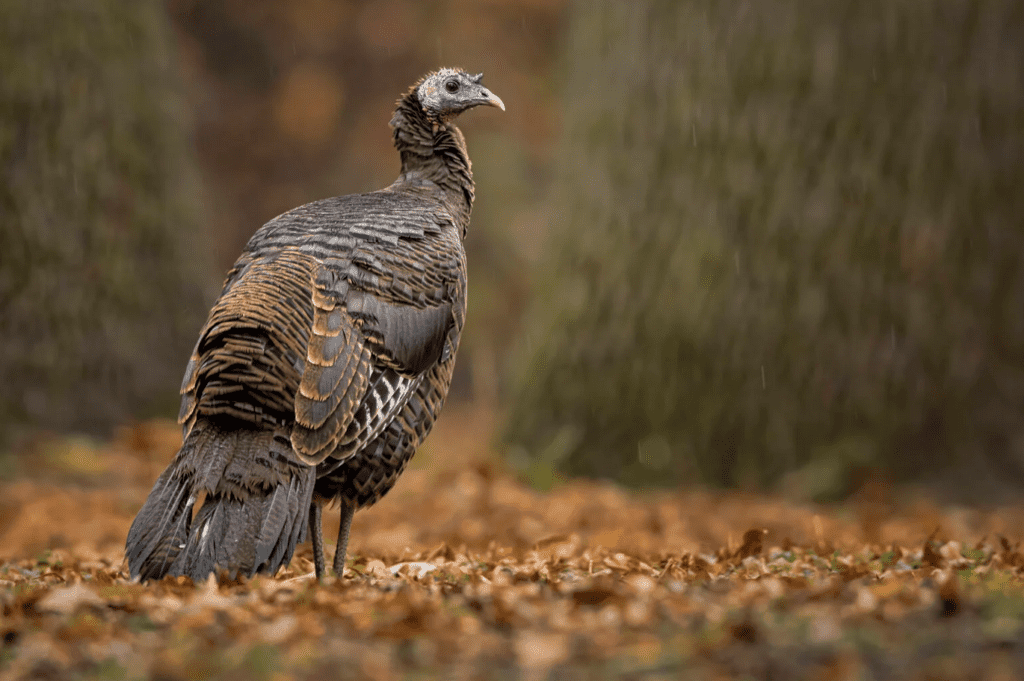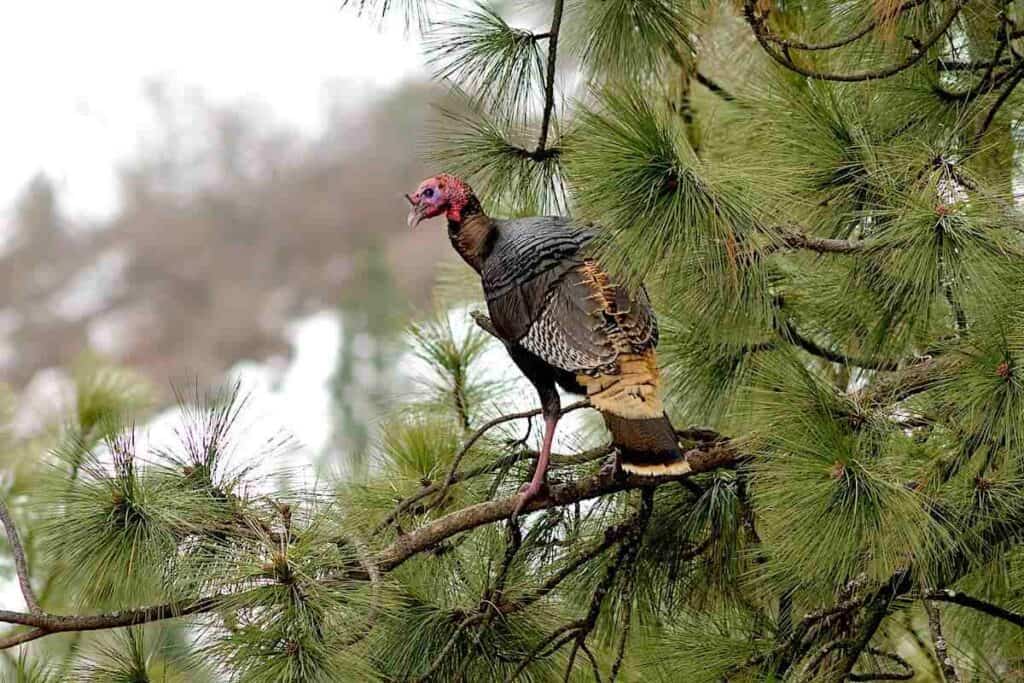While turkeys can be successfully hunted at any time during the day, the most popular time to hunt them is at the crack of dawn and in states where it is legal, just before dusk. The best way to successfully hunt these times begins with locating a turkey roost.
To find a turkey’s roost, use maps and knowledge of the territory to identify high probability areas. They like the eastern side of the hills where the sun will reach them first in the morning. Turkeys use trees they feel safe and protected in that are near where they want to start their morning.
This article will explain the methods used to locate turkey roosts, as well as the landscape and terrain features to look for and how you can put all these pieces together for a successful turkey hunt in the morning or the afternoon.
The Perfect Roost
It is no secret that turkeys roost in trees. Trees provide protection from predators lurking on the ground as well as give some protection from the weather. The location of these roost trees is heavily influenced by the terrain.

What to Look For
Like all animals, turkeys need food, water, and shelter. When searching for a roost location, keep an eye on areas that provide these three things. Another feature to keep in mind is an open area, commonly referred to as a “strut zone”. A tom, or jake for that matter, prefers an open area whether it be open woods or a field or meadow to strut and show their stuff.
Popular landscape and terrain features to look for are ridges, fields, clearcuts, and water sources. The edges of water sources and fields are classic locations for turkey roosts, but don’t overlook wooded ridges.
As mentioned before, food is important to all living things, and with turkeys, this is no different. When they wake up they like to pitch down into areas that they can begin to feed, much like when you wake up hungry for breakfast. The best roost sites tend to be close to food sources, which also often coincides with good strutting areas.
Did You Know I Had a Newsletter?! 📬
I do! I send out a weekly email that talks all about deer hunting and is a bit more personal than a regular article. If you sign up right now, I will even send you the first chapter of my Ebook “The Hunters Guide to Scent Control” for free! What is there to lose? 🙂
Best Locations
As far as exact location, a turkey will prefer to roost part way down a ridge, often on the east facing slope where the sun shines first in the morning unless inclement weather pushes them to a different location with better protection.
Turkeys will generally roost in the same area throughout the spring, but the exact tree is dependent on the weather. For example, on windy days they will choose a roost on the leeward side of a ridge closer to the bottom and often in thicker timber.
Turkeys seek protection from not only the weather but also predators. Regardless of how perfect the tree is that they are roosting in, if they are pushed off their roost multiple times and begin to feel unsafe they will find a new tree.
The perfect roost tree is one that provides the most protection. This is often one of, if not, the largest in the area with many stout branches that grow at a right angle from the trunk. Although the species of tree is not necessarily as important as the physical attributes, pine trees seem to be a top choice because of the protection they provide.
Map It Out
The tools and applications that turkey hunters have at their fingertips make for much more efficient and easier scouting. Apps like OnX, Hunstand, or the many others that now exist allow for scouting and logging information at all times of the year. These are excellent tools to use and when used correctly will change your turkey hunting strategy for the better.
Use these maps to divide a large area into smaller high probability areas to concentrate your search when you get out in the field. A little research with a map before you go aimlessly walking through the woods will save valuable time and increase your chances of finding turkey roosts and other great hunting locations.
The best way to pick apart a property is by looking at topo maps and satellite imagery. These maps will give you a very good idea of the terrain. You can pick out ridges, water sources, possible strut zones, and food sources. Once you have pinpointed possible areas simply by dropping a pin, it is time to hit the field and see it first-hand.
Once you are in the field, if you can locate large concentrations of turkey scat, this is a sure sign that you have located the roost site. Turkeys will feed heavily when they pitch down in the morning and before they head up for the night, so another good indication that a roost is near is a heavily scratched up area in the leaves from feeding.

Watch Them Roost
Now that you know what areas to concentrate your search on, it is time to make sure that there are actually turkeys currently using the roost. There are a few techniques to accomplish this and one surefire way is to actually see them using the roost.
Grab a pair of binoculars and take a ride. The best places will be where you have seen turkeys hanging around during the afternoon an hour or so before dusk. These places will be relatively close to where they are roosting and will allow you to exactly pinpoint their roost.
If you do not instantly see turkeys, get comfortable and listen. You may hear some clucks and yelps and maybe even a gobble. If you want to, you can slip a little closer trying to stay undetected until you can get eyes on them. If you don’t get into visual range, you will be able to hear their wing beats as they fly up to roost.
If you are not able to physically watch them or hear them fly up to their roost, then you may be able to pick them out on the skyline sitting comfortably on a branch. Getting a visual bead on a roost can change the game for the next morning especially if that gobbler decides he doesn’t want to talk.
Make a Turkey Talk
Probably the most fun and definitely the most common practice to locate a turkey roost is by making them gobble. This method of locating an active roost gives you the ability to locate turkey roosts from long distances. The most important thing to keep in mind is that just because you don’t hear them doesn’t mean they aren’t there.
This method is commonly referred to as “roosting”, and is the act of making a turkey “shock gobble”. This can be accomplished by using a variety of sounds referred to as locator calls. Some of the most popular locator calls are owl, crow, and coyote calls. The use of air horns and other loud noises has also proven to be effective, although not necessarily recommended.
When to Get a Turkey to Respond on the Roost
The sound you decide to use to roost a turkey isn’t as important as the time of day. You need to roost a turkey when he is on the roost. A turkey is on the roost from right around dusk until daybreak for the most part. The problem is that the window that they will gobble is very small. Don’t expect to go out 2 hours after dark and get a turkey fired up with an owl call.
The best time frame for roosting a turkey is within an hour or so on either side of sundown and within an hour of daybreak. For some reason, it seems that the morning is the more productive of the two times. Unfortunately, this leaves less time to change hunting plans if you’re relying on hunting a roosted bird.
Planning a Roost Trip
When going out to roost turkeys, it is best to use your time to roost as many sites as possible, this is why it is important to pick a route. You don’t have all night or all morning to get a turkey to gobble, so there are a couple of options to maximize your time out roosting. The first is making a route that you can drive to several spots quickly and the second is picking out high spots.
The choice of most is to plan out a driving route and hit as many possible turkey hunting locations as possible. This is effective if you have several places with some distance between them because you can drive faster than you can walk. It may not be as effective in bigger woods areas where you can’t drive within listening distance of much of the area.

Locator Calling Locations
The best method in big woods settings or larger areas of ground that are unreachable by vehicle is to pick out the highest point to call from. Ideally, this will be a location in which you can hear as close to 360 degrees as possible. Calling from high points allows your call to reach turkeys from greater distances and you can pinpoint roosts across a much wider area.
There is no better feeling and confidence boost for a turkey hunter than having a gobbler fire up on his roost the night before the hunt. If you do decide to roost a turkey, make sure to take note of the location of the gobble. When you figure out a plan for the morning, your chance of success increases dramatically, just be careful not to get in too tight and bump him.
Put The Pieces Together
Now that you have located a turkey in its roost, it is time to take that knowledge and apply it to your hunt. There is more to just knowing where a turkey roosts walking in and harvesting him. You need to take into account the location of the tree, how open it is around, your route of entry, how close you can get, and where he flies down.
Knowing where the roost tree is is great, but knowing the direction a turkey pitches down in the morning is even better. You are much better off waiting for him when his feet touch the ground than waiting under his tree as he flies a couple of hundred yards away to head somewhere else for the day.
If you have watched a turkey in the minutes preceding them flying to its roost, this is a good indication of where it may start its day. If you have not, then it’s time to use your turkey hunting knowledge and pick out a good food source, or open area that that gobbler may want to begin his day strutting in.
If you have all of these pieces put together, the last part is picking an entrance. The best scenario is getting in undetected within 75-100 yards of his roost and getting him to think he’s got a hen all to himself that he can fly right off the limb too. Unfortunately, this is not always the case, get as close as you can without being seen, if you are detected it’s all over.
To hunt a turkey that you have roosted, your plan of attack must be well thought out. Sometimes what seemed like a gimme turns into a struggle to figure out how to get into his bubble undetected. Put the pieces together, if you know where a turkey is roosted and you know where he flies down, that turkey should be slung over your shoulder shortly after daybreak.
Final Thoughts
Finding a turkey roost is just another technique to help you be a more successful turkey hunter. It’s another tool for the toolbox. Turkeys may not gobble as much as the day goes on but they can still be successfully hunted throughout the daylight hours in areas far away from their roost trees.
As a hunter, locating a turkey roost is a major confidence boost and it can dramatically increase your chance of success, especially first thing in the morning and late in the afternoon. Simply locating a roost is by no means a guarantee that you will be giving a gobbler a ride home in your truck. What roosting a turkey does give you is the early morning advantage and confidence of an exciting morning.
Sister Post | How Often Should You Call When Turkey Hunting?
A sister post is another post that I have written that follows along with the same topic as the one you just read. After reading this article, you will probably like this next one even more! Here is a little teaser…
Excitement levels during a turkey hunt can range from exhilarating to depressing. Mine are often somewhere in between until I strike up a bird. Then I’m beyond excited. Other than a bugling bull elk, no other game animal is as exciting to hear as a gobbler in the spring…Keep Reading
Spring Scenarios
Spring is the most popular time of year to hunt and try to call in turkeys. Spring is the breeding season and the easiest time to call in lovestruck toms…Keep Reading
Striking up a Tom
Getting a tom to gobble otherwise known as striking up a tom, is often the first thing that you will try to do on a hunt. If it’s not, it should be. The only scenario where you might not want to do this is when…Keep Reading
Thank you for reading my article! I hope you enjoyed it, and if you have any questions or feedback, please send me an email at [email protected]. If you want to learn more about me or Omega Outdoors, visit my About Page. Otherwise, I hope you have a great day, and check out some of my other articles while you’re here!

